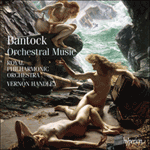
Welcome to Hyperion Records, a British classical label devoted to presenting high-quality recordings of music of all styles and from all periods from the twelfth century to the twenty-first.
Hyperion offers both CDs, and downloads in a number of formats. The site is also available in several languages.
Please use the dropdown buttons to set your preferred options, or use the checkbox to accept the defaults.

Published with accompaniment for piano in 1908 and for orchestra in 1909, the Sapphic Poem is notable for its delicate and romantic orchestration: double wind (only one oboe), two horns, one trumpet, triangle and strings, but no heavy brass, and, surprisingly, no harp. This allows the cello to sound clearly through the texture but nevertheless gives Bantock’s romanticism every chance to express itself. H O Anderton, who as well as being the author of the first full-length book on the composer was also Bantock’s general factotum and a composer and poet himself (and so well-placed to know what was intended in the music), wrote that the music is ‘full of the erotic sentiment of the Sappho songs and almost the whole is founded upon the motto phrase with which the Poem opens’. After rising to a big climax about half way through, followed by a brief cadenza for the soloist and a second climactic passage, the music gradually dies away as languorous, voluptuous tendrils of melody entice us to hope that Bantock’s exotic and scented picture will not fade.
The music is prefaced by a short quotation from Sappho: ‘and this I feel in myself’, the fifteenth fragment in Wharton’s translation.
from notes by Lewis Foreman © 1997
Publié avec un accompagnement d’abord pianistique (1908), puis orchestral (1909), le Sapphic Poem vaut surtout pour son orchestration subtile et romantique: vents doubles (un hautbois seulement), deux cors, une trompette, un triangle, des cordes, mais pas de cuivres lourds et, fait surprenant, pas de harpe. Ce qui permet au violoncelle d’être intelligible à travers la texture, tout en laissant libre cours au romantisme de Bantock. H. O. Anderton – qui, en plus d’être l’auteur du premier ouvrage complet sur Bantock, dont il fut le factotum, était lui-même compositeur et poète (et donc bien placé pour connaître le dessein de la musique) – écrivit que la musique «regorge du sentiment érotique des chants de Sappho, et presque tout l’ensemble repose sur la phrase conductrice qui ouvre le Poem». Après s’être élevée jusqu’à un imposant apogée quasi central, suivi d’une brève cadence pour la soliste et d’un second passage paroxystique, la musique se meurt peu à peu, de langoureuses et voluptueuses volutes mélodiques attirant sur nous l’espoir que l’image exotique et parfumée de Bantock ne s’évanouira pas.
extrait des notes rédigées par Lewis Foreman © 1997
Français: Hypérion
Das Sapphische Gedicht, das mit Klavierbegleitung im Jahr 1908, und in der Orchesterversion im Jahr 1909 erschien, zeichnet sich durch seine gefühlvolle und romantische Orchestrierung aus: doppelte Bläserbesetzung (nur eine Oboe), zwei Hörner, eine Trompete, Triangel und Streicher, aber keine schweren Blechblasinstrumente und überraschenderweise auch keine Harfe. Dadurch hat das Cello die Möglichkeit, seine Stimme innerhalb des Kompositionsgefüges deutlich vernehmen zu lassen, wobei Bantocks romantische Ader in nicht minderem Umfang zum Ausdruck kommt. H. O. Anderton, der nicht nur der erste war, ein abendfüllendes Buch über den Komponisten Bantock verfaßt zu haben, sondern auch dessen Faktotum war (nebenbei war er selbst Komponist und Dichter, und so gut bewandert, daß er wußte, was in den Kompositionen beabsichtigt war), schrieb, daß die Musik ‘voller erotischer Gefühle gleich den Sappho-Liedern ist und sich so gut wie ausschließlich auf das Motto, mit dem das Gedicht beginnt, gründet’. Nachdem es sich ungefähr auf halbem Wege zu einer großen Klimax emporschwingt, dem eine kurze Kadenz des Solisten und eine zweite Klimax folgt, schwindet die Musik in schläfriger, sinnlich rankender Musik allmählich dahin und verleitet uns zu der Hoffnung, daß Bantocks exotisches und von Gerüchen durchdrungenes Bild nicht verblassen möge.
aus dem Begleittext von Lewis Foreman © 1997
Deutsch: Inge Schneider
 Bantock: Orchestral Music Bantock: Orchestral Music‘Bantock's prodigious output as a composer … rested in the long grass for decades until Vernon Handley's Hyperion recordings revealed the many qu ... ‘What an achievement! Twenty-one late-romantic orchestral works in one box at mid-price or better. Bantock's lavish romanticism is superbly served by ...» More |

